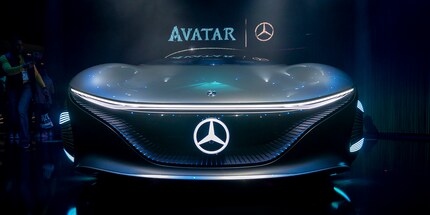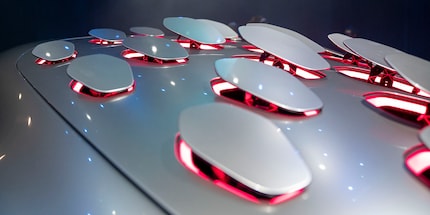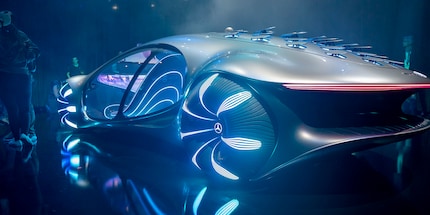
Background information
The future of automated vehicles is the Wild West
by Philipp Rüegg
One of the two big topics at the CES in Las Vegas is transport. The questions: How will we be driving in five or ten years' time? And even more exciting: How can we reinterpret technology so that it drives?
The comment from user Fabian under the Feed on CES 2020 sounds ominous: he wants to know more about "Level 4 and 5 Autonomous Vehicles". So that we are all on the same page: The five levels of driving, as the automotive company BMW defines them.
In practice, this can take strange but interesting forms. Because at CES 2020 in Las Vegas, there are two topics that dominate: Women and their role in the tech world and the future of mobility. No one doubts that both women will change the world in the next five years and that the way we get around will be radically different.
In this article, I am focussing on cars. The reason is not that there are no electric scooters or EV trucks around, but the car is the one that is most likely to move and also offers enough space as a physical object to pack the whole range of technology in a mobile way. But yes, there are also lorries - where battery range is the most important thing - and electric scooters, which are mainly advertised as a service.

The car, which is essentially a ball on wheels, is definitely out. Where last year, everyone was still driving around a car park in one of these cucumbers, both new manufacturers and traditional car makers are coming up with new ideas and shapes.
Ford is showing off this year and quickly hangs a Ford Mustang Mach E on the wall. Outside, in front of the Main Hall, is a Ford Mustang GT500 Shelby. Two cars that are both impressive in their own way. The GT500 is an 820 hp powerhouse with a 5.2 litre engine. The Mach E marks a change of direction, as the Mach E is an electric vehicle (EV). In general: If you're not presenting an EV, then you must not want to present at CES.

Ford is taking a risk with the Mach E, because drivers expect something from the word Mustang. The Mustang has power, is a bit wild and makes a lot of noise. You hear the GT500 long before you see it. That's why the Mach E, with its tablet in the centre of the console and its electric motor, faces harsh criticism.
However, Ford is not deterred. According to information at the stand, pre-orders are going well and the Mach E is proving very popular with the trade public. Far more exciting than the vehicle itself are the things standing around the Mach E. There is a petrol pump that resembles a Tesla Supercharger, but in blue and white with the Ford logo.

Ford believes in the future of the EV.
With this comes a myriad of possibilities. With comparably simple means, most on-board systems can be automated and smartened up. Therefore, as a technological relic, the GT500 falls more into the level 1 defined by BMW, with a hint of 2, while the Mach E is solidly in the second level with hints of level 3.

The big surprise comes from Sony. The company is known for many things: Games consoles, audio systems, TVs, cameras and pretty much anything else you can think of. If it needs a plug, you can be sure that Sony has done it at some point.
Now Sony is showing a car. The Vision S is the highlight of the Japanese company's stand. Not because everyone wants to buy it - it is not yet known whether the Vision S will ever go on sale - but because it shows one thing: The power of technology.
The concept behind the Vision S is not to create a "Tesla killer". Because this term is often used. Is this the car that will knock the Tesla off its throne? Yes, no, maybe... but Sony is not asking itself that question. Sony wants to show what its technology can do.
The sensors in the car come from Sony's Imaging Division, so they're the same ones you'd find in a Sony camera. The sound comes from the Sound Division, where 360-degree adaptive sound has just been developed. The screens in the car are provided by Sony's TV division. All of these parts are powerful, compact and beautiful enough to power a level 3 car, with some level 4 in there, and at least theoretically make it ready for production. As the parts come from all corners of Sony, there is little standing in the way of series production of the Vision S.

From stage 4 onwards, we hear dreams of the future. Very little is set in stone and there are two main thrusts at the CES. There is the travelling bubble, which jerks along and doesn't look like a car at all. It is intended to replace public transport and democratise the car. Think of it as a kind of autonomous Uber system. You use an app to call a moving bubble to the tip of your nose, tell it where to go and then you sit down and do something until you get there. You don't have to drive. Or only in exceptional cases. These systems, clearly level 5, are still dreams of the future. There is a prototype that looks like what the real thing should look like one day. Driving is still only half possible, usually on fixed routes with assistance and on-board troubleshooting. But for last-mile transport, i.e. transfers at the airport with fixed routes and only people as obstacles and a few traffic rules, it works.
Somewhere in the valley between levels 4 and 5 is one of the major highlights of the trade fair: The Mercedes Benz Vision AVTR. Named after the film "Avatar" and inspired by the ideas of Hollywood director James Cameron on his fictional planet Pandora, the Avtr does a lot differently. Pretty much everything. And it works. The Avtr is a roadworthy prototype that did the rounds in traffic in Las Vegas a few days ago.
As a passenger, you no longer have any buttons in the Avtr. Only a kind of knob - where you have the gear stick in a normal car - serves as a physical control element. The Avtr senses and recognises the rest itself. When you raise your hand, a laser projects symbols onto your palm. If you close your hand, the Avtr accepts the command. Mercedes thus quickly overcomes all language barriers.

The seat measures your heart rate and makes the control element in the centre and the lights and spoiler cells at the rear pulsate to this rhythm. The seat vibrates to the rhythm of your heartbeat. As strange as it sounds, this has an immediate calming effect. When the man at the stand says that the Avtr aims to be a kind of extension of yourself, I believe him and, after trying it out, I'm not so sceptical about the concept. The Avtr feels good and familiar, even if pretty much all the reference points of a normal car Cockpit are missing, and not just because of the thing with the pulse. It's the smooth lines, the gentle feedback, the ease of use - I doubt anyone will ever have to read an owner's manual for the Avtr - and the seat that moulds to you.

While driving, the Avtr takes care of everything, but does not completely disempower the driver. The control element can be used to either drive the car itself or to give it impulses. "Drive faster" is a push forwards, "Turn into the motorway service area" is a push to the right. The technological intelligence behind this is breathtaking. Because if you tell the Avtr that you want to turn right, it somehow works like this:
All of this has to happen in just a few fractions of a second in a constantly changing world and flowing traffic. That's great and compared to the moving bubbles, I - just like many of those present at the stand - think the Avtr has a better chance of success in terms of "This is the future of cars".
Both the Mercedes Avtr and the Sony Vision S are vehicles whose technology does not seem inherently alien or like something out of a science fiction film. We know the camera systems, the sensors, the synchronisation with databases and the big data features. At CES, however, we see one thing above all: a new interpretation of the technology.
This is exactly why CES is so exciting. We see things we know, but remixed. Engineers and inventors have squatted down and critically scrutinised existing devices, broken them down to their core function and rebuilt them, wrapped them in a new shell.
This way of thinking inevitably leads to our world changing. At the moment, individual transport is close at hand and back in the editorial team Las Vegas - a dining table in an Airbnb - we ask ourselves: What's next?
Journalist. Author. Hacker. A storyteller searching for boundaries, secrets and taboos – putting the world to paper. Not because I can but because I can’t not.
Interesting facts about products, behind-the-scenes looks at manufacturers and deep-dives on interesting people.
Show all